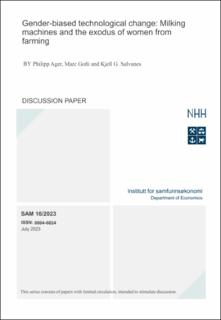| dc.description.abstract | This paper studies the link between gender-biased technological change in the agricultural sector and structural transformation in Norway. After WWII, Norwegian farms began widely adopting milking machines to replace the hand milking of cows, a task typically performed by women. Combining population-wide panel data from the Norwegian registry with municipality-level data from the Census of Agriculture, we show that the adoption of milking machines triggered a process of structural transformation by displacing young rural women from their traditional jobs on farms in dairy-intensive municipalities. The displaced women moved to urban areas where they acquired a higher level of education and found better-paid employment. These findings are consistent with the predictions of a Roy model of comparative advantage, extended to account for task automation and the gender division of labor in the agricultural sector. We also quantify significant inter-generational effects of this gender-biased technology adoption. Our results imply that the mechanization of farming has broken deeply rooted gender norms, transformed women’s work, and improved their long-term educational and earning opportunities, relative to men. | en_US |
